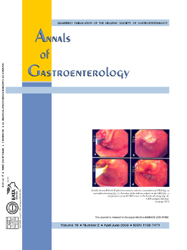Inflammatory Bowel Disease (IBD) and the Liver
Abstract
Hepatobiliary Diseases (HBDs) accompanies in a 5-10% ofpatients with Inflammatory Bowel Diseases (IBD). They are
either extra-intestinal manifestations or drug side effects.
The main extra-intestinal manifestation is Primary Sclerosing
Cholangitis (PSC), which as an entity, includes the
former pericholangitis, now called small duct Primary
Sclerosing Cholangitis. It mainly affects young males with
ulcerative colitis. It is a chronic cholestatic disease with a
broad spectrum of clinical manifestations. The asymptomatic
disease has a better prognosis than the symptomatic
one. It eventually leads to cirrhosis and is the 4th cause of
orthotopic liver transplantation. Cholangiocarcinoma is the
most ominous complication and its presence is also accompanied
by increased frequency of colon dysplasia or cancer.
A less frequent complication is the ascending cholangitis
with or without (pigmented) biliary stones.
Auto-immune Hepatitis (type-1) is another extra-intestinal
manifestation of IBD, but its frequency seems to be very
low under the new diagnostic criteria, compared to the frequency
reported in previous publications. An overlap syndrome
may also occur.
Fatty liver is the commonest occurring liver disease, specially
in patients with ulcerative colitis and is usually indolent.
Uncommon manifestations include granulomas and granulomatous
hepatitis, amyloidosis and hepatic abscesses.
Biliary stones are often related to Crohns Disease, probablydue to altered bile component balance.
Drugs used for the treatment of IBD may cause liver damage,
either acute or chronic. Azathioprine and cyclosporine
are newly recognized as such dings. Alertness, proper use
and serial tests for monitoring the liver function and morphology
can minimize their side effects. More sophisticated
tests are not yet routine clinical practice.




